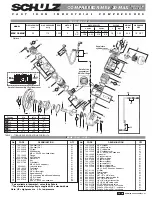
Operating conditions
When choosing a refrigerant, different aspects
must be taken into consideration:
• Legislation (now and in the future)
• Safety
• Application envelope in relation to expected
running conditions
• Compressor capacity and efficiency
• Compressor manufacturer recommendations &
guidelines
Additional points could influence the final
choice:
• Environmental considerations
• Standardisation of refrigerants and lubricants
• Refrigerant cost
• Refrigerant availability
R22 is an HCFC refrigerant and is still a wide
use today. It has a low ODP (Ozone Depletion
Potential). Starting from 1st January 2010, the
use of virgin R22 refrigerant is no longer allowed
in the European Union. Refer to FRCC.EN.049 for
R22 retrofit recommendations.
When R22 is applied in refrigeration applications
it can lead to high discharge temperature.
Carefully check all other parameters that can
influence the discharge temperature.
R407C is an HFC refrigerant and has a zero ozone
depletion potential (ODP=0) R407C is a zeotropic
mixture and has a temperature glide of 45.3°F
but has a superior thermodynamic properties
compared to R22.
R404A is an HFC refrigerant and has zero
ozone depletion potential (ODP = 0). R404A
is especially suitable for low evaporating
temperature applications but it can also be
applied to medium evaporating temperature
applications. R404A is a mixture and has a very
small temperature glide, and therefore must
be charged in its liquid phase, but for most
other aspects this small glide can be neglected.
Because of the small glide, R404A is often called
a near-azeotropic mixture.
R507 is an HFC refrigerant with properties
comparable to R404A. R507 has no ozone
depletion potential (ODP = 0). As with R404A,
R507 is particularly suitable for low evaporating
temperature applications but it can also be
used for medium evaporating temperature
applications. R507 is an azeotropic mixture with
no temperature glide.
Mineral oil can be applied in system using HCFC's
refrigerant because it has a good miscibility
with HCFC and oil that leave the compressor
with refrigerant may not be trapped in lines or
exchangers. The chlorine contained in HCFC's
improves lubricity in bearings used with mineral
oil. Mineral oil has a very low hygroscopicity but
may chemically react with water and form acids.
Polyol Ester Oil (POE) is miscible with HFC's
(while mineral oil is not), but has to be evaluated
regarding lubricate ability in compressors.
POE oil has better thermal stability than
refrigerant mineral oil. POE is more hygroscopic
and also holds moisture more tightly than
mineral oil. It also chemically react with water
leading to acid and alcohol formation.
R134a is an HFC refrigerant and has zero ozone
depletion potential (ODP = 0). R134a is a pure
refrigerant and has zero temperature glide. For
applications with high evaporating and high
condensing temperatures, R134a is the ideal
choice.
General information
R22
R407C
R404A
R507
POE oil
Mineral oil
R134a
Refrigerant and lubricants
The scroll compressor application range is
influenced by several parameters which need to
be monitored for a safe and reliable operation.
These parameters and the main
recommendations for good practice and safety
devices are explained hereunder.
• Refrigerant and lubricants
• Motor supply
• Compressor ambient temperature
Application envelope (evaporating temperature,
condensing temperature, return gas
temperature)
25
FRCC.PC.003.A5.22
Application guidelines
















































